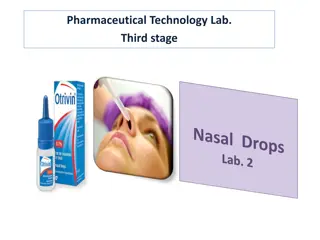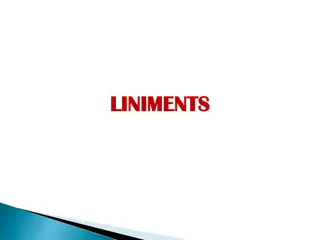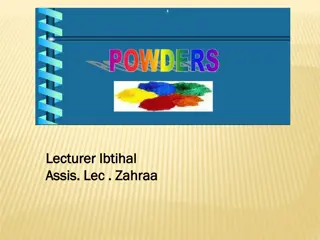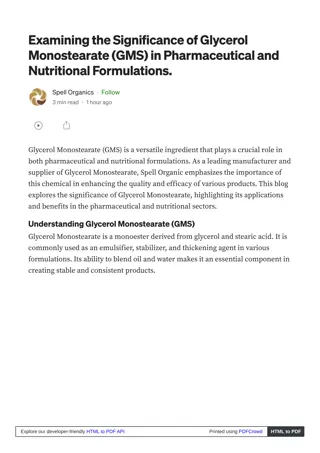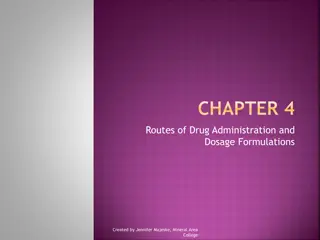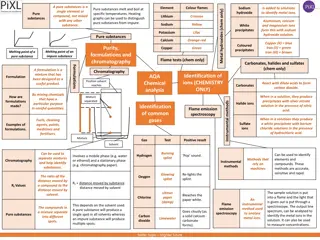Understanding Liniments: Uses, Formulations, and White Liniment Preparation
Liniments, also known as embrocations or heat rubs, are topical preparations used for pain relief and stiffness. They contain ingredients like alcohol and counterirritant compounds such as menthol. The type of liniment and desired action dictate the solvents used. A specific example is the formulation of white liniment using ingredients like turpentine oil and oleic acid. The preparation involves emulsification to create a water-in-oil emulsion.
Download Presentation

Please find below an Image/Link to download the presentation.
The content on the website is provided AS IS for your information and personal use only. It may not be sold, licensed, or shared on other websites without obtaining consent from the author. Download presentation by click this link. If you encounter any issues during the download, it is possible that the publisher has removed the file from their server.
E N D
Presentation Transcript
It is also called embrocation and heat rub, is a medicated topical preparation for application to the skin. Some liniments have viscosity similar to that of water; others are lotion or balm; still others are in transdermal patches, soft solid sticks, and sprays. Liniment usually is rubbed in to the skin, which the active ingredients penetrate.
Liniments are typically use to relieve pain and stiffness, such as from muscular aches and arthritis. These are typically formulated from alcohol, acetone, or similar quickly evaporating solvents and contain counterirritant aromatic chemical compounds, such as methyl salicilate, benzoin resin, and menthol. They produce a feeling of warmth within the muscle of the area they are applied to, typically acting as rubefacients via a counterirritant effect.
The type of action desired .e.g, LINIMENTS with alcoholic or hydro-alcoholic vehicles are useful in instances in which rubefacient, counterirritant, or penetrating action is desired. While oleaginous liniments are employed primarily when massage is desired. Solubility of the desired components in the various solvents. Liniment that are emulsions or that contain insoluble matter must be shaken thoroughly before use to ensure an even distribution of the dispersed phase. For oleaginous liniment the solvent may be fixed oil or volatile oil or it may be a combination of fixed and volatile oils.
White liniment (Emulsion type liniment) Rx Ammonium chloride 12.5 g Dilute ammonia solution 45 ml Oleic acid 83.3 ml Turpentine oil 250 ml Water 625 ml Ft. emulsion
Procedure 1)Mix turpentine oil and oleic acid in a bottle 2)Add an equal volume of warm water (50 C) to a dilute ammonia solution. Then add this dilute solution (in small amount to the oily liquid), shake vigorously after each addition 3)Dissolve the ammonium chloride in the rest of the water and add it to the bottle (in small amount) and shake vigorously after each addition
Note: In white liniment, turpentine oil is emulsified with NH4 oleate produced from oleic acid and dilute ammonium solution, and this emulsifying agent (ammonium oleate) is oil in water emulsifying agent (monovalent soap) but the preparation also contain NH4Cl which due to common ion effect depress the ionization of the soap and decrease the solubility in water, this together with high percent of turpentine oil in the liniment cause phase inversion producing water in oil emulsion.
NH4Cl NH4 Oleic acid + NH4 + + Cl- + NH4oleate 1- NH4Cl is used as a laxative but here as a system acidifier 2- Dilute ammonia solution is used as a system circulatory stimulant but here is used as a source of alkali. 3- Oleic acid is used as a source of free fatty acid. 4- Turpentine oil is used as counterirritant.


